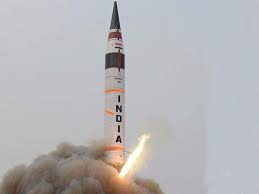Agni V Missiles:

China has cited a United Nations Security Council (UNSC) resolution to question India’s missile programme amid reports of an upcoming test for the Agni-V intercontinental ballistic missile.
- UNSC Resolution 1172 was issued after India’s 1998 nuclear tests.
About Agni V Missiles:
- Agni-V is the most advanced surface-to-surface indigenously built ballistic missile.
- It is a three-stage, solid fuelled, 17-metre tall missile, and is capable of carrying a nuclear warhead of about 1.5 tonnes.
- Agni-V is a fire and forget missile, which once fired cannot be stopped, except by an interceptor missile.
- It has been developed under the Integrated Guided Missile Development Programme (IGMDP).
- IGMDP was conceived by Dr. A.P.J. Abdul Kalam to enable India attain self-sufficiency in the field of missile technology. It was approved by the Government of India in 1983 and completed in March 2012.
- The 5 missiles (P-A-T-N-A) developed under this program: Prithvi, Agni, Trishul, Nag, Akash.
Agni Class of Missiles:
- They are the mainstay of India’s nuclear launch capability.
- Range:
- Agni I: Range of 700-800 km.
- Agni II: Range more than 2000 km.
- Agni III: Range of more than 2,500 Km
- Agni IV: Range is more than 3,500 km and can fire from a road mobile launcher.
- Agni-V: The longest of the Agni series, an Inter-Continental Ballistic Missile (ICBM) with a range of over 5,000 km.
- Agni-P (Prime): It is a canisterised missile with range capability between 1,000 and 2,000 km. It will replace the Agni I missile.
- The missile has been successfully tested five times and is in the process of induction into the Army.
- Very few countries, including the US, China, Russia, France and North Korea, have InterContinental Ballistic Missiles (ICBM).
- ICBM is a land-based, nuclear-armed ballistic missile with a range of more than 5,600 km.




